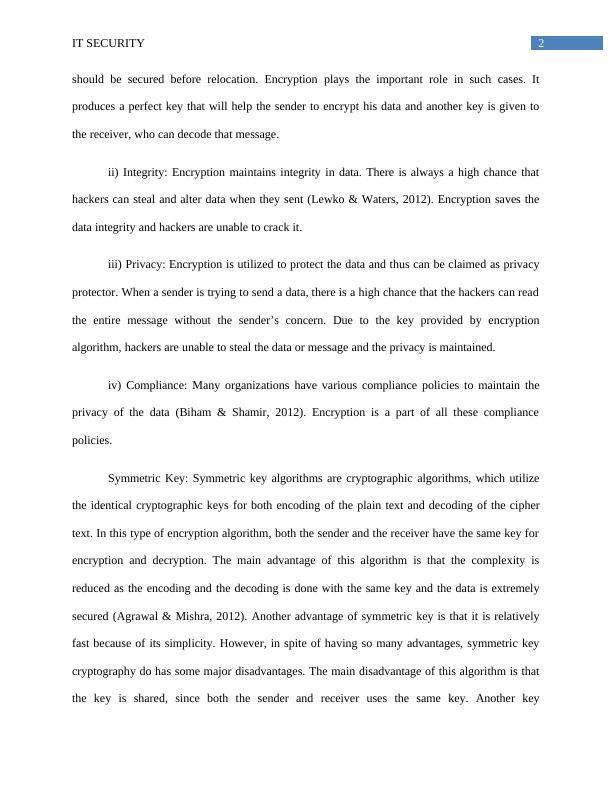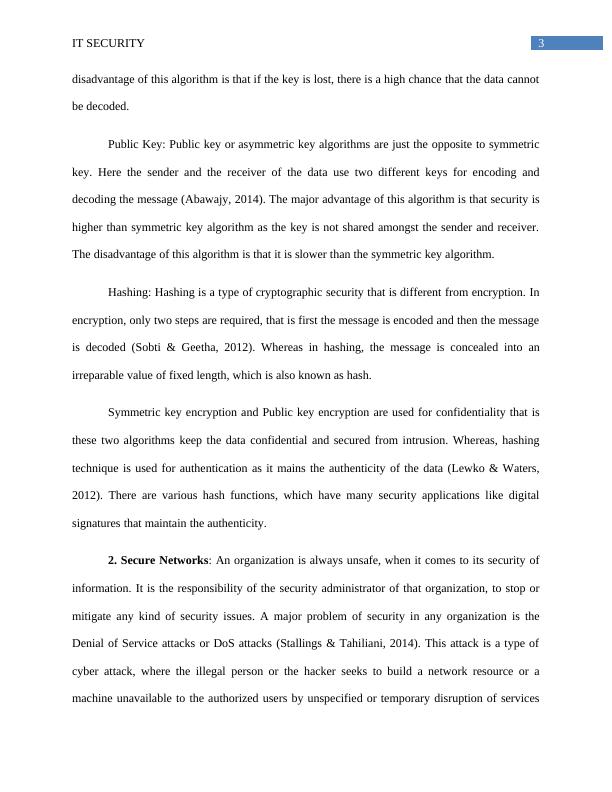Ask a question from expert
Types of Computer Security Techniques
14 Pages4116 Words383 Views
Phoenix College
Information Security (CMGT 441)
Added on 2020-02-24
About This Document
IT security refers to the protection of various computer systems against the loss or theft of data, software, or hardware, as well as the tampering or misrepresentation of the services they provide. The four types of computer security strategies are described in the following paper. Encryption, secured networks, access control, and firewalls are the four aspects of fundamental computer security.
Types of Computer Security Techniques
Phoenix College
Information Security (CMGT 441)
Added on 2020-02-24
BookmarkShareRelated Documents
Running head: IT SECURITYIT SecurityName of the StudentName of the UniversityAuthor’s Note:

1IT SECURITYIT securityis the safety of various computer systems from the destruction or theft to theinformation, software or hardware, as well as from distortion or misleading of all the servicesprovided by them (Behnia, Rashid & Chaudhry, 2012). There are various types of IT securitiesfor example, firewalls, encryption, access control, secured networks, and passwords. All thesetechniques are utilized to make the security of the computer systems strong.The following essay outlines the four basic types of computer security techniques. Thefour basic types of computer security are encryption, secured networks, access control andfirewalls (Abawajy, 2014). This essay covers all the required details of the four mentionedcomputer securities. The description of above discussion is given below.1. Encryption: Encryptionis the procedure of concealing a data or message in such away that only sanctioned users will be access it in cryptography. It does not prevent itselfinterference, but rejects to a would be interceptor, the understandable content. The expected dataor message, which is cited to as aplaintext, is concealed using an encryption algorithm,originatingcipher textthat can only be read if decoded in an encryption algorithm (Lewko, &Waters, 2012). An encryption algorithm usually utilizes apseudo randomencryption keyproduced by an algorithm for various technical reasons. It is in moral possibility to decode thedata without getting the encryption key. However, for a well designed encryption algorithm,major computational skills and resources are needed. A sanctioned recipient can decode the dataeasily with the encryptionkeygiven by the generator to receivers however, never to theunauthorized users (Biham & Shamir, 2012). The advantages of encryption are as follows:i) Security: The major advantage of encryption is the security. Data is endangeredwhenever it is relocated from one place to another. Therefore, it is evident that data or message

2IT SECURITYshould be secured before relocation. Encryption plays the important role in such cases. Itproduces a perfect key that will help the sender to encrypt his data and another key is given tothe receiver, who can decode that message. ii) Integrity: Encryption maintains integrity in data. There is always a high chance thathackers can steal and alter data when they sent (Lewko & Waters, 2012). Encryption saves thedata integrity and hackers are unable to crack it.iii) Privacy: Encryption is utilized to protect the data and thus can be claimed as privacyprotector. When a sender is trying to send a data, there is a high chance that the hackers can readthe entire message without the sender’s concern. Due to the key provided by encryptionalgorithm, hackers are unable to steal the data or message and the privacy is maintained.iv) Compliance: Many organizations have various compliance policies to maintain theprivacy of the data (Biham & Shamir, 2012). Encryption is a part of all these compliancepolicies. Symmetric Key: Symmetric key algorithms are cryptographic algorithms, which utilizethe identical cryptographic keys for both encoding of the plain text and decoding of the ciphertext. In this type of encryption algorithm, both the sender and the receiver have the same key forencryption and decryption. The main advantage of this algorithm is that the complexity isreduced as the encoding and the decoding is done with the same key and the data is extremelysecured (Agrawal & Mishra, 2012). Another advantage of symmetric key is that it is relativelyfast because of its simplicity. However, in spite of having so many advantages, symmetric keycryptography do has some major disadvantages. The main disadvantage of this algorithm is thatthe key is shared, since both the sender and receiver uses the same key. Another key

3IT SECURITYdisadvantage of this algorithm is that if the key is lost, there is a high chance that the data cannotbe decoded. Public Key: Public key or asymmetric key algorithms are just the opposite to symmetrickey. Here the sender and the receiver of the data use two different keys for encoding anddecoding the message (Abawajy, 2014). The major advantage of this algorithm is that security ishigher than symmetric key algorithm as the key is not shared amongst the sender and receiver.The disadvantage of this algorithm is that it is slower than the symmetric key algorithm. Hashing: Hashing is a type of cryptographic security that is different from encryption. Inencryption, only two steps are required, that is first the message is encoded and then the messageis decoded (Sobti & Geetha, 2012). Whereas in hashing, the message is concealed into anirreparable value of fixed length, which is also known as hash.Symmetric key encryption and Public key encryption are used for confidentiality that isthese two algorithms keep the data confidential and secured from intrusion. Whereas, hashingtechnique is used for authentication as it mains the authenticity of the data (Lewko & Waters,2012). There are various hash functions, which have many security applications like digitalsignatures that maintain the authenticity.2. Secure Networks: An organization is always unsafe, when it comes to its security ofinformation. It is the responsibility of the security administrator of that organization, to stop ormitigate any kind of security issues. A major problem of security in any organization is theDenial of Service attacks or DoS attacks (Stallings & Tahiliani, 2014). This attack is a type ofcyber attack, where the illegal person or the hacker seeks to build a network resource or amachine unavailable to the authorized users by unspecified or temporary disruption of services

End of preview
Want to access all the pages? Upload your documents or become a member.
Related Documents
Encryption Symmetric Key Encryptionlg...
|9
|2853
|351
Cryptographic Techniques Assignment Solutionlg...
|6
|1264
|132
Security in Computing and IT PDFlg...
|3
|619
|13